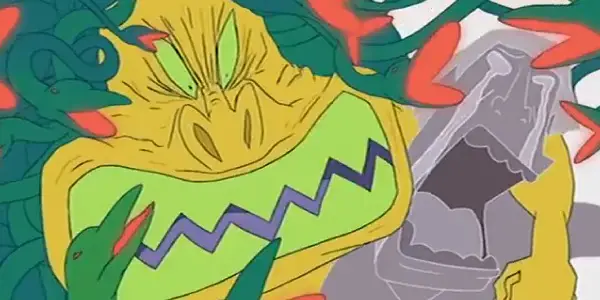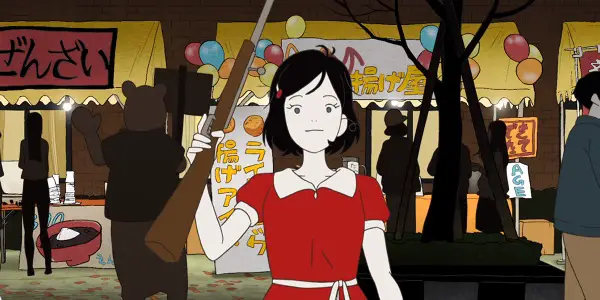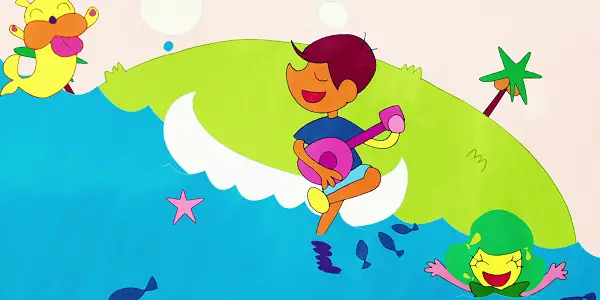The Beginner’s Guide: Masaaki Yuasa, Director

Ben is a former student of cognitive science who is…
When Masaaki Yuasa has been asked to comment on his own work, his responses have expressed a consistent theme: a love of variety in animation, with respect both to artists’ unique styles and audience’s tastes. He believes audiences are more open to stylistic diversity than some people expect, and wants his artistic collaborators to feel satisfied. It’s only natural, then, that you’d be hard-pressed to come across work that resembles his.
In a 2011 interview chronicled here, Yuasa said a driving force of his career was the artistic variety his early collaborators encouraged. Almost from the moment he finished schooling, he started animating professionally. He worked under people who were flexible about letting him do what he wanted, artistically, and letting him participate in different parts of the animation process. That flexibility allowed him to discover what satisfied him most about working in animation.
He draws on variety not only in the workplace he shares with his collaborators, but also in the history of animation. The influences he cites encompass all kinds of different styles and technologies of animation from all over the world. The simple, lanky geometry of his characters has its roots in one place; his way of incorporating photographs into drawings has its roots in another. Still other influences are at the roots of his odd sense of perspective, his unnatural colors, and the quaking fluidity his most expressive sequences seem to have.
The viewer who seeks them out will find inspirations from surrealist animation from 1960s and ’70s, from other major figures in Japanese animation, and from a wide section of American animation (he’s named both Tex Avery cartoons and Golden Age Disney films as favorites). He embodies the spirit of the variety he values. This holds both for original projects like his 2009 TV series Kaiba and adaptations like his 2004 film Mind Game.
Speaking of which:
Mind Game (2004)

Mind Game was Masaaki Yuasa’s first feature film; he wouldn’t make another one until 13 years later. It’s arguably the least focused of his films, but it’s also one of his most artistically adventurous works. Its plot is difficult to summarize, not because it’s complicated, but because a simplified description of the events that take place in Mind Game really wouldn’t tell you anything about the movie.
The premise is that a few young adults, on the run from the Yakuza, end up trapped in the belly of a whale. During their time in the whale, the characters take part in flights of fantasy and bizarre works of art. These mental exercises and acts of play – mind games – are the focus of the film. The ecstasy the characters make for themselves and the ways it deepens their relationships are visualized with some rather bizarre (but extremely satisfying) sequences of animation, characterized by Yuasa’s tendencies toward frenetic acting and scatological humor.
It casts its eye from sprawling cityscapes to the microscopic motions of cells in the human body. It draws surprising connections between the characters and twists chronology to explore alternative possibilities. In Mind Game, to have imagination is to depart from the world, but only temporarily. Eventually, you’re drawn back toward it with a more intense affection for the new and unexplored. Mind Game‘s appeal, though, lies less in the articulation of this idea than its lack of inhibition.
The Night is Short, Walk on Girl (2017)

The Night is Short, Walk on Girl is based on a story by novelist Tomohiko Morimi. In 2010, Masaaki Yuasa served as director on Tatami Galaxy, an 11-episode TV series based on another of Morimi’s novels. Both adaptations are expressionistic, depicting things to the audience in terms of the characters’ emotions toward the things they encounter.
But while Tatami Galaxy provides us mainly with a vision of only the main character’s impressions of the world, The Night is Short lets the impressions of various characters overlap. It follows an unnamed college student’s effort to have fun over the course of one night. She encounters all kinds of people and places with rich histories, and finds something satisfying about all of them.
Each character brings some quirky energy to the table. It manifests in surreal imagery that invades the screen or the exaggerated contortions of their bodies. Maybe their heads and necks will inflate to several times their original size as they try to swallow a massive piece of food; or maybe, out of sheer dejection, they’ll manifest a cyclone powerful enough to blow the outlines off another character.
It creates a good environment for the main character. She makes the most of her night by embracing as much as she can of the people and events around her. Her confidence and curiosity contribute a lot to the movie’s appeal, even when it shifts gears into its less festive final movement.
Tatami Galaxy was also the story of a college student seeking satisfaction, but its main character was more anxious and frustrated with his pursuits. A lot of viewers found that relatable, especially those who watched it while in college. The Night is Short, Walk on Girl might not have that same effect, but it’s no less lively or detailed than Tatami Galaxy. It exudes charisma, and is easily Masaaki Yuasa’s most tightly-written feature film to date.
Lu Over the Wall (2017)

Lu Over the Wall is narratively messier than The Night is Short and not as uniquely bizarre as Mind Game. It picks up many thematic threads, but doesn’t follow any of them very far. The influence of technology on the expression of young people, the loss of loved ones, the expansion of industry, and other things all figure into the story, but don’t feel very fully explored by the end of the film. Nevertheless, you might find it worth your time to see it if you get the chance. It has an interesting visual structure which gives it a consistency the script doesn’t reach by itself.
It’s about a boy named Kai, and the folkloric mermaids who inhabit the water in the harbor town where he lives. The reason the story seems untidy is because it keeps taking departures from its focus on the characters’ problems to marvel at the mermaids. This pattern is mirrored visually: the film is punctuated by sequences of extravagant animation that stand out from the less expressionistic mode in which most of the film is animated. Both narratively and visually, the film starts with something that feels ordinary, makes some dreamlike departure, and then comes back.
If you look at all its thematic threads, you’ll find that they all involve processes of change and growth. The consistent thing about Lu Over the Wall is that it keeps finding dilemmas in these processes. The mermaids want to express their love for everything, but are easily taken advantage of. Kids find outlets for their unique interests, but easily become expendable because those outlets don’t value them personally. And so on. It’s fitting that one of the first ideas introduced in the film is that of the siren’s song. The siren’s song calls you to action, and offers wisdom to those who answer the call; but it also leads the careless to a bad place.
Viewers who know animation history will notice that some scenes are inspired by East Coast animation from the early 20th Century. It’s interesting to see how it interacts with the film’s more avant-garde inclinations, and the comparatively recent technology used to make it. The siren’s song spells doom for the careless, but Lu Over the Wall displays careful attention to the past even in its aims for progress. For those who like this sort of thing, it’s a fascinating film.
Final Thoughts, For Now
Both The Night is Short, Walk On Girl and Lu Over the Wall were produced by studio Science Saru, which Masaaki Yuasa founded in 2013 with fellow animator Eunyoung Choi. Science Saru is currently working on the production of a new Netflix series to be directed by Yuasa, but it’s likely the studio will produce more feature films in the future.
In the meantime, if you’re interested in Masaaki Yuasa‘s work, a good place to start might be the 13 minute short Kick-Heart, which is available to rent on Vimeo. Yuasa also directed stand-alone episodes of the TV series Space Dandy and Adventure Time that serve as good, compact examples of his style. If you like all of those, then the films on this list will probably be for you; if you still want more, then his TV work should give you plenty of material to explore. At this point, it’s safe to expect more fresh and adventurous work in the near future, not only from Yuasa himself, but also from Choi and his other close collaborators.
What are your thoughts on Masaaki Yuasa?
Does content like this matter to you?
Become a Member and support film journalism. Unlock access to all of Film Inquiry`s great articles. Join a community of like-minded readers who are passionate about cinema - get access to our private members Network, give back to independent filmmakers, and more.
Ben is a former student of cognitive science who is currently trying to improve his writing style and ability to understand and appreciate films containing unfamiliar perspectives. He tries not to hold films to a strict set of criteria, but does believe that strong movies can change your outlook on the world. His favorite films include Whisper of the Heart, Hellzapoppin', Foolish Wives, 42nd Street, and the work of Charlie Chaplin.













